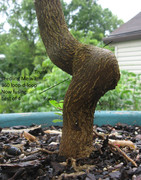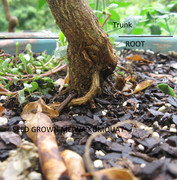I was recommended by several european people to use Mediterranean soil for my citrus as it doesn't dry out too quickly and because the 5-1-1 soil won't work (we don't have the same kind of bark and it starts to compost and do nasty stuff)
I followed a guide from a dutch website
https://www.allimone.nl/citrus-limon/ (which I had to purchase, since this pdf is not free) and in that guide they too recommended
- to cover the drainage hole of terracotta pot with something such as a piece of a broken terracotta pot
- add a thin layer of expanded clay pebbles to improve drainage
- use Mediterranean soil mixed with perlite
- water in summer : 1l for plants smaller than 0.5m and 4L for plants bigger than 1m each week (more if theres a heat wave)
turns out the core of the root ball is drying out faster than the soil around it, the soil in the entire container stays too wet so I'd need to wait 2 weeks but despite that root rot still happens.
Granted I am using for some plants pots that are too big, but for 3 I managed to get a pot that was about 5 - 10cm wider (no more than that) so that would be an appropriate upgrade. Yet these are suffering from the same problem too.
In response to these issues I first mixed my soil with a larger amount of perlite (30% or so) but the soil didn't dry out enough.
I started noticing leaf drop (as I posted in some earlier topics) and yellowing / browning branches and that told me root issues,
I repotted all of them and added another 30% pumice (4 - 8mm size was all I could find from a german bonsai shop on amazon

) to further improve drainage. While gently removing the root balls out of the soil, I noticed that the size of the root balls of some of them reduced , some even by 50%
I also removed the expanded clay pebbles as others here mentioned they do harm for citrus.
So my questions:
- since my drainage can no longer be improved because I already did what I could, how can I decrease the time for the soil to dry out? (we had a few weeks of hot sun but after that much cloudy and rainy weeks, during rain I place them under a roof outside so the soil doesn't get even more wet.
- watering amount: i know many will say this is difficult to answer, I even looked up a table to calculate how many galllons for the canopy size and that came close to the amount I found in that PDF but I still think for a freshly bought citrus plant in a 20cm pot dimeter with height of 60cm of plant (as mentioned on the site of oscar tintori) that 1 liter / week is too much. I started giving 0.5 liter but still seems to be too much. soil won't dry. (it feels dry on the top until the first knuckle of my finger and moist below that, never wet or sopping wet, but moist for so long is not good for citrus)
Is is perhaps a better idea to water 250ml with an accurate cup in the center of the root ball / week so it gets less water and should be dry by the next week?
Because, I know many will say "water only when it's dry or when you need to, not at regular intervals" and that's fine for me too but if my plant has root issues from this then I don't agree.
PS: the shards to cove the holes I use are not flat, they allow water to freely leak out, because they're somewhat curved. it's just to prevent the soil from clogging the hole.
Is there anything else I can do? I put them outside in the morning sun as much as possible but right now our summer is awful, the air humidity is high and we need more sun. and if it' not that then we get heat waves for which these young and now stressed plants are unable to withstand.
Side question: I have a pursha that was bought in a 30cm pot, this plant was bigger, but lost half its root ball due to heat wave (40+°C in greenhouse) it's still alive but losing a leaf or 2 a day, it's still has a lot of flowers and I was wondering if it's a good idea to remove them so he can concentrate on growing. I don't mind not having fruit next year, I want healthy plants.







 )
)
